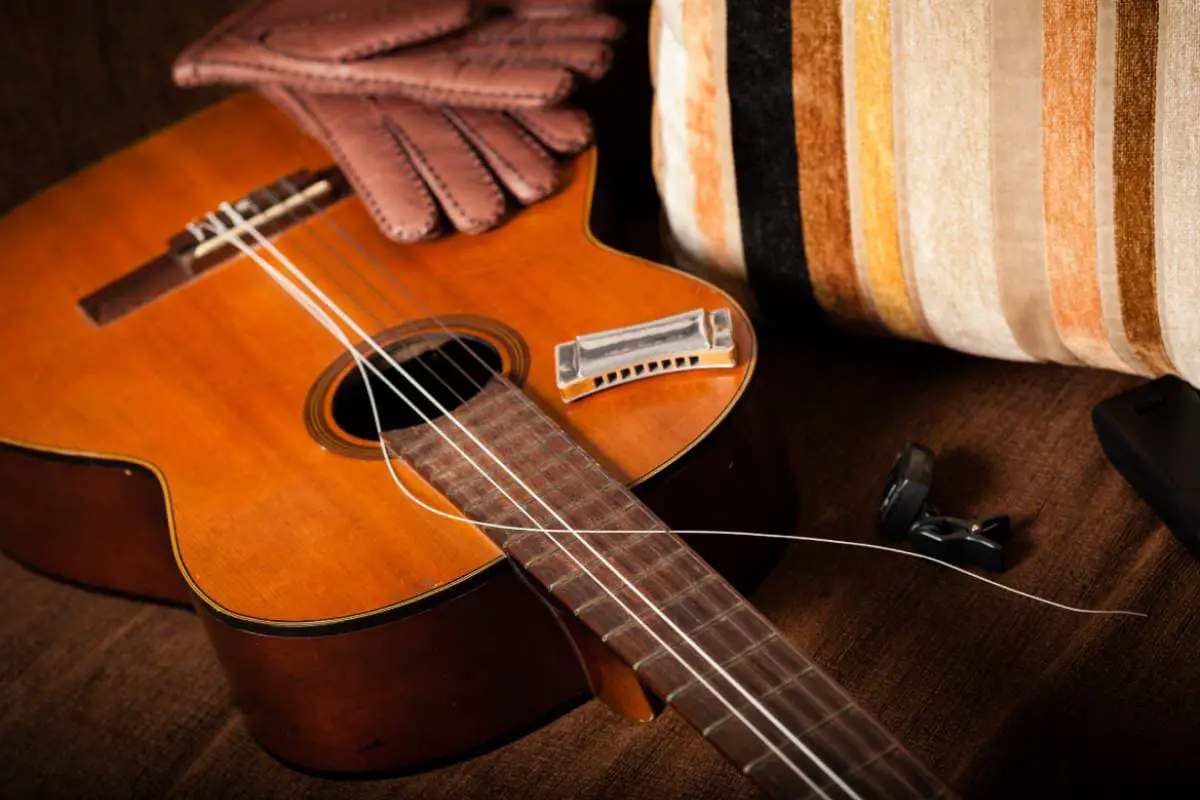If you play the guitar, you will inevitably have to deal with broken strings. Whether you are a seasoned professional or a novice, it is best to know how to deal with a broken guitar string so that you know exactly what to do when it happens to you.
Here are eight ways to deal with a broken guitar string:
- Change your guitar.
- Use the whammy bar.
- Learn to play on five strings.
- Forget about playing a solo.
- Make use of strumming.
- Change the string that broke.
- Replace your strings regularly.
- Stay calm and confident.
In this article, we will look at how you can use the above eight tips to deal with a broken guitar string. Let’s get started!
👇😀👇NOTE👇😀👇
If you want to find out what my recommended guitar gear is, then here is what I recommend on Amazon:
- Fender Cutaway Acoustic-Electric Guitar Bundle (MY FAVORITE GUITAR)
- Snark SN-8 Super Tight All Instrument Tuner (Easiest Tuner I’ve Used😏)
- 6 String Acoustic Guitar Capo (Best CAPO for quick changes)
- Dunlop Max Grip 1.0mm Nylon Picks (Thick Guitar Pick So You Don’t Lose Grip!)
- Universal Guitar Stand (Cheap & Minimalist Guitar Stand I Recommend)
- Levy’s 2″ Wide Quick Adjust Guitar Strap (Best Guitar Strap For Any Level)
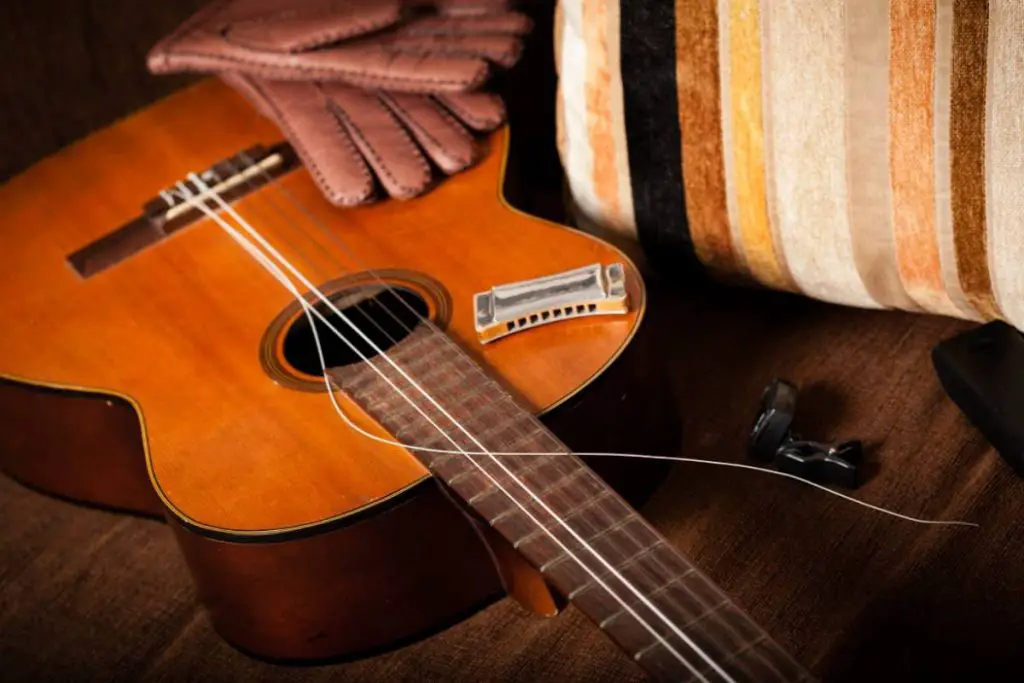
1. Change Your Guitar
The first and most obvious tip is simply swapping your guitar, but it might not always be that easy. If you are merely strumming along at home, breaking a guitar string is not that big of a problem, but it could turn into a catastrophe on stage.
It all depends on the circumstances.
If, for instance, you are a one-man band in a small coffee shop and you don’t have a spare guitar, it might be possible to finish the song and take a quick break to change the string.
On the other hand, if you are performing on stage with a band for a big audience, you can’t just stop playing.
If this happens, you need to rely on the band to keep the song going, play along as best as you can, using the five strings you have left while your sound guy brings you a spare guitar. You should always have a backup guitar as a professional or semi-professional guitarist (Related: do professional guitarists use tabs).
As a band, you should have somebody who can help you deal with these situations. A good idea would be to practice switching the guitars before it happens on stage. Being prepared will help you stay calm and for the switch to go smoothly.
Your sound guy will wait for the right moment to approach you. As soon as you see him coming toward you, unplug your guitar gently, don’t rip out the cord, and loosen your strap if you are using one.
He will take your guitar and hand you the spare guitar. Quickly plug it in and continue playing.
Here is a YouTube video showing you an amazing example of how to switch your guitar without stopping the performance.
2. Use the Whammy Bar
Whammy bars sound super cool if you know how to use them (See this post: Why Does Your Whammy Bar Not Work? 9 Problems and Fixes), and if one of the strings on your electrical guitar breaks, the whammy bar might be able to help.
Using the whammy bar, you can lessen the tension of the strings by pressing it towards the body of the guitar. On the other hand, if you want more tension on the strings, you can do so by pulling the whammy bar away from the guitar’s body.
Using the whammy bar in this fashion might help you get through the song you are playing before switching guitars.
This will, however, not work on a Floyd Rose guitar with a floating tremolo. If one of the strings of this guitar breaks, all the strings will go out of tune, and you won’t be able to play.
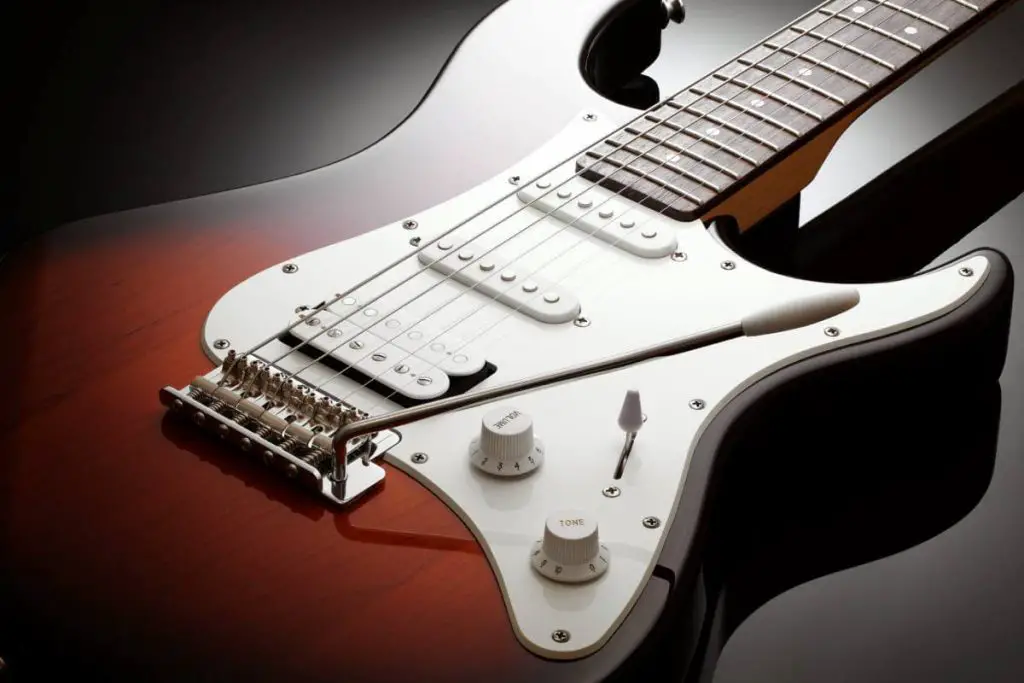
3. Learn To Play on Five Strings
You might not know all the chords and tricks that come with years of experience if you are starting out, but it is possible to play on five strings.
You will have to improvise and won’t have time to think about it, but you can carry on playing and finish the song using only five strings. Hang on to some notes as much as possible and play others using different strings.
If you know your chords, you should be able to work around a broken string.
If breaking a string on stage is something that scares you and is keeping you up at night before the day of your gig, you can always try to practice playing with five strings.
You know the songs you will be playing, so remove the string that is most likely to break and figure out how to play the songs with five strings.
You might never have to do it, but it will help you feel more confident when getting up on stage.
4. Forget About Playing a Solo
Playing a guitar solo is super fun and a fantastic way to entertain the crowd, but if one of your guitar strings breaks, then you might find it hard to recover. Most songs can be played without a guitar solo, so leave the solo unless it is essential, and you can switch guitars in time.
Trying to play an impressive solo on five strings might not sound like it should; instead, let one of the other band members play a solo or do a more acoustic version of the song.
If the crowd noticed that your string broke, they might be even more impressed by your guitar playing skills if you can finish the song with five strings.

5. Make Use of Strumming
Depending on what type of guitarist you are, you might enjoy playing rhythm guitar or prefer picking or shredding. Whichever way, knowing how to strum will be super helpful if one of your strings breaks on stage.
Playing with only five strings is not ideal (whether you can do it or not), but you only need to get through the song you are performing. Once done, you can switch your guitar or quickly replace the string while one of your band members entertains the crowd.
Many people start off learning guitar by strumming, and if one of your strings breaks mid-song, falling back to it can be helpful.
6. Change the String that Broke
When a string breaks while you are at home and not performing, you can stop playing and change the broken string. if, however, you are on stage, finish the song (if possible) and then take a quick break.
At this point, you can switch guitars or change your string.
Changing one string shouldn’t take long, and you can even have your sound guy do it for you, if you have one, while you take a bathroom break or grab a quick drink.
If you are part of a band, make sure that one of your bandmates entertains the audience while tending your broken string.
Presuming all the other strings on your guitar are relatively new, replacing only one string shouldn’t be a problem (beware of guitar string snap injury). If the other strings are worn, you might hear a difference in sound as the new string might be louder and crisper.
It is always best to replace all your strings simultaneously for a better-balanced sound, but if you are in the middle of a performance and don’t have an extra guitar, replacing only the broken string will suffice.
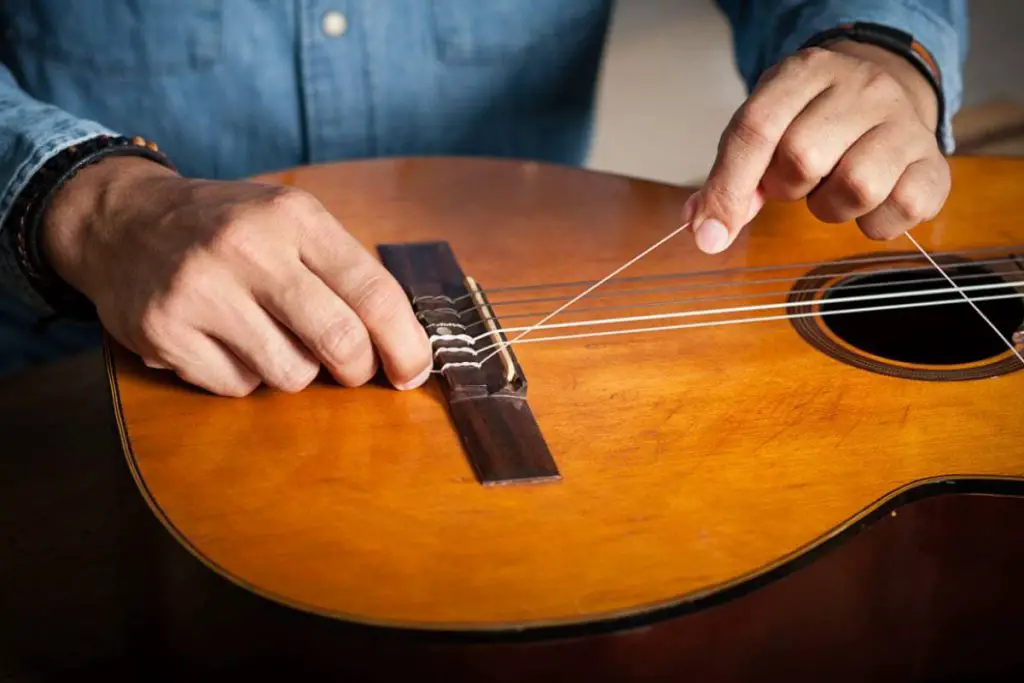
7. Replace Your Strings Regularly
Breaking guitar strings is unavoidable, but replacing them regularly can help avoid a catastrophe on stage.
Use the correct gauge string, considering that high gauge strings are much more durable but brutal on the fingers.
There is no specific recommended timeframe to change your strings, but as a guitarist, you should be able to hear when the strings are worn out. New strings will sound clear and vibrant, whereas worn strings will sound dull.
If playing guitar is a hobby and you mostly play at home, you can change your strings whenever you feel like it or even wait until one of them breaks.
On the other hand, if you perform regularly and practice often, you should look at changing your strings every second week to avoid them breaking on stage.
How To Prevent Guitar Strings From Breaking
Although guitar strings are bound to break, there are some things you can do to increase their lifespan. Whether you are short on cash or hate changing strings, you can try these methods to make your strings last longer.
- Wash your hands before playing. Not every guitarist does this, but it is an easy way to prolong the life of your strings. Don’t eat or make food while playing the guitar and if you have to touch something oily, wash your hands before you continue playing.
- Keep your guitar clean. While playing, the oil and dead skin from your hands transfer onto your strings, which can make your strings brittle. To prevent a build-up of dirt on your strings and guitar, it’s best to wipe your strings and fretboard after playing.
- Buy good quality strings. Cheap strings will break much faster than good quality ones, which although pricey, tend to last longer. You can get these Elixir Acoustic Guitar Strings Phosphor Bronze with NANOWEB Coating from Amazon.com.
The above strings come in a variety of thicknesses, and you can buy a single set or three-pack. These acoustic guitar strings will give you a fantastic sound and have a NANOWEB coating that prevents corrosion, thereby enhancing durability.
- Don’t reuse old strings. You might think of keeping some of your old strings, but it is not a good idea. Instead, keep a pack of new strings and some loose new strings as spares. Replacing a broken string with an old one will affect the guitar’s sound quality.
Taking good care of your guitar and strings is the best way to ensure your strings last longer and don’t break in the middle of a performance.
You can get this Dunlop 6582 Ultraglide 65 String Conditioner (available on Amazon.com) to help extend the life of your strings. It comes with a felt dauber top. You simply dispense some of the conditioners on the dauber and clean your strings. It protects the strings from corrosion and sounding dull.
Why Guitar Strings Break
Like most things, guitar strings wear out, become brittle and break. How long they last depends on you. There are many contributing factors why guitar strings break; however, you can make them last longer if you take good care of them.
Here are four of the most common reasons why guitar strings break:
- Sharp edges – There may be some sharp edges on your guitar that are causing your string to break. If the same strings keep breaking in the same place, this might be your problem. Have a look at your frets, bridge, tuning capstans, and nuts; if you find a sharp edge, no matter how small, file it down so that it is smooth.
- Heavy strum – Look at your strumming technique. Playing with a lot of force might be the reason why your strings break frequently. Heavy strumming is particularly popular when it comes to rock bands, so if this sounds like you, try to strum softer. Your playing will sound the same, and your strings will last longer.
- You bent it – Guitar strings are thin, and it is super easy to bend them while stringing your guitar. If your string breaks and you don’t know the reason, chances are there could have been a kink in it. When stringing your guitar, be careful to keep the strings straight.
- Corrosion – Dirt and rust can build up on your strings if you don’t take good care of them. Dirt and oil from your skin get onto the strings and lead to gradual corrosion, so it is best to always clean your strings.
If your guitar strings keep breaking and you can’t figure out the cause, you can take your guitar to a guitar shop for them to have a look at it. Sometimes the issue is so small that the untrained eye can’t see it.
Guitar Repair Tools
Whether you play on stage in front of a crowd or in your living room, ensure that you always have extra strings and tools. The worst thing that can happen to any guitar player is a string breaking in the middle of a set and not having any replacement strings.
You can get this MIFOGE Guitar Repairing Maintenance Tool Kit (available on Amazon.com) to take with you to every gig or practice session. It has all the tools you need to repair your acoustic or electric guitar so that you never have to panic if your guitar string breaks again.
It includes various tools that you will need to restring your guitar or repair it, such as crowning luthier files, bridge pins, a string winder, and a string cutter. You will also get needle files, a grinding sponge, a grinding stone, and a wiping cloth.
A repair kit is necessary so that you can quickly change a string or do some essential repairs.
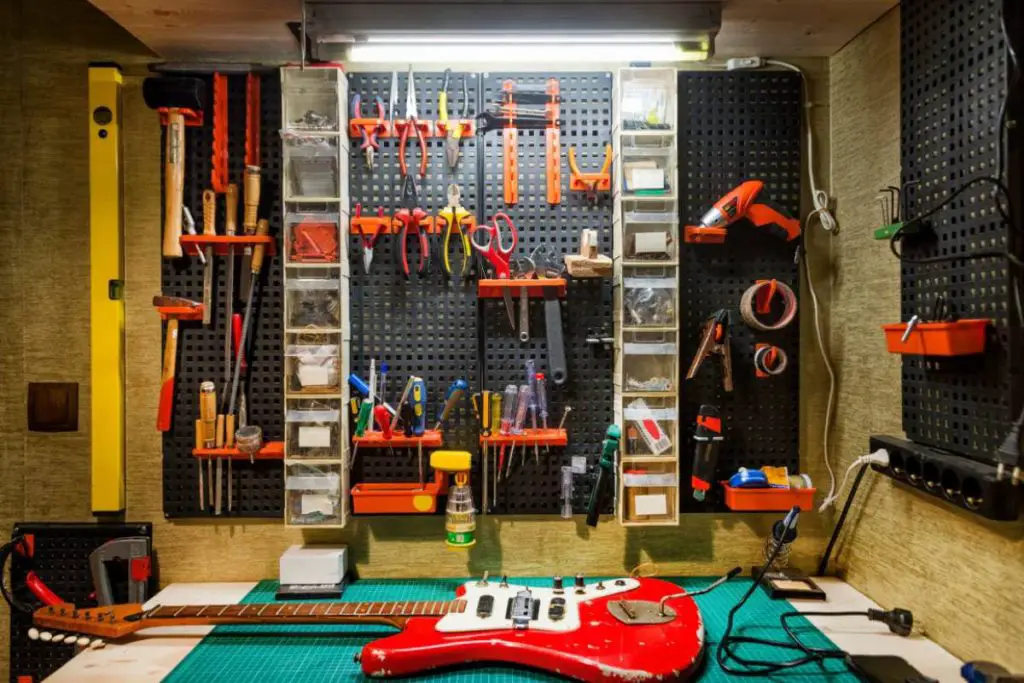
Guitar Stringing Methods
Familiarizing yourself with replacing your own guitar strings will help if your string breaks on stage and you need to quickly replace it between songs (relevant article: do guitar picks break?). Many people take their guitars to the guitar shop for somebody to replace the strings, but you should know how to do it yourself.
There are a few different stringing methods, and many people will argue about which way is the best. However, it doesn’t matter, find a way that works for you and use it.
As long as the strings are replaced and tuned correctly without any damage, you will be able to enjoy playing your guitar and entertaining the crowd.
Some people believe that you should change your strings one at a time, meaning that you remove one string, usually starting with low E, and then replace it before moving on to the next one.
Other people will remove all the strings and then replace them; whichever technique you choose, make sure not to bend your strings or over-tighten them.
8. Stay Calm and Confident
One of the best tips I can give you is to stay calm. Do not panic when your string breaks. It happens to every guitar player, whether you are a novice or a professional.
If you are practicing at home, there is no reason to panic anyway–just replace the broken string, or all of them and carry on playing.
But if you are on stage performing, staying calm and confident is the best thing you can do.
If you can play on five strings, do so until the song ends, then switch guitars. If you can’t continue playing, let your drummer go into a drum solo or talk and entertain the crowd while your sound guy brings you the replacement guitar.
The audience is usually more understanding than you think and might even enjoy some random, improvised entertainment.
Final Thoughts
Dealing with a broken guitar string can be stressful, but it doesn’t have to be if you follow these tips. The best option is always to switch your guitar if possible and then change all of your strings.
Ensure you always have extra strings and a repair kit on hand and know how to change a string quickly. If you can play on five strings, that can help a lot until you finish the song.
Most importantly, entertain the crowd and stay confident.
👇😀👇NOTE👇😀👇
If you want to find out what my recommended guitar gear is, then here is what I recommend on Amazon:
- Fender Cutaway Acoustic-Electric Guitar Bundle (MY FAVORITE GUITAR)
- Snark SN-8 Super Tight All Instrument Tuner (Easiest Tuner I’ve Used😏)
- 6 String Acoustic Guitar Capo (Best CAPO for quick changes)
- Dunlop Max Grip 1.0mm Nylon Picks (Thick Guitar Pick So You Don’t Lose Grip!)
- Universal Guitar Stand (Cheap & Minimalist Guitar Stand I Recommend)
- Levy’s 2″ Wide Quick Adjust Guitar Strap (Best Guitar Strap For Any Level)
Related Posts:

